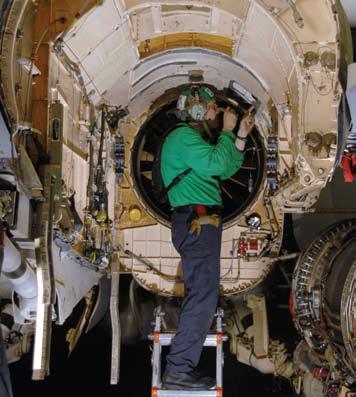
12 minute read
Maintainers in the Trenches
AE3 Stephen Bell, assigned to the “Kestrels” of VFA-137, performs maintenance on the engine bay of an FA-18E Super Hornet aboard the Nimitz-class aircraft carrier USS Abraham Lincoln (CVN-72). Navy photo by MC3 Rialyn Rodrigo
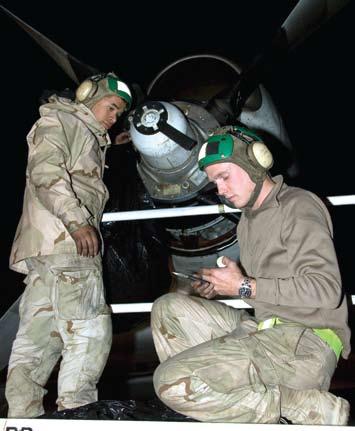
Advertisement
ADAN Zechariah Edwards and AD3 Daniel Childress perform maintenance on the engine of a P-3C Orion aircraft. Navy photo by MCSN Meagan Klein
Gunnery Sgt. Pablo Dominguez, left, and Cpl. Zach Versteegh, both assigned to HMM-265, perform maintenance checks on a CH-46 Sea Knight helicopter in the hangar bay of the forward-deployed amphibious assault ship USS Essex (LHD-2). Navy photo by MC3 Gabriel Weber Aviation ordnancemen assigned to VFA-195 attach a missile to the wing of an FA-18C Hornet strike fighter before cyclic flight operations aboard the aircraft carrier USS Kitty Hawk (CV-63). Navy photo by MC2 Carlos Gomez
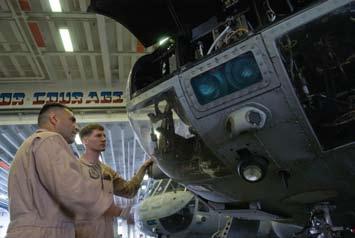

NAVAIR Aircraft Launch and Recovery
By Joann MacRae
Intro-“Holdback Fitting Failure” by Lt. Adam J. Smith, an FA-18 pilot with VFA-83, was taken from the Naval Safety Center website and truly demonstrates why Flight Safe was developed. I walked to the FA-18 Hornet and conducted my regular preflight inspection. The startup and subsequent taxi to the catapult were routine. What happened Selecting ground idle with both throttles, I threw down the arresting hook and stood on the brake pedals as if my life depended on it. My Hornet stopped accelnext was anything but ordinary. erating down the cat track, but it was still sliding toward
After the aircraft entered the catapult track, the the forward edge of the deck. In a final attempt to stop holdback fitting was attached, and I was armed up by before pulling the ejection handle, I drove down the the ordnance men. The taxi director stood on my right right rudder pedal in an effort to ground loop the airside between the tower and the cat as he gave me the craft. The jet rotated 90 degrees to the right and contin“take tension” sign. With all of the take-off checks comued to skid down the angle. I now was staring straight at pleted, I saluted the catapult officer. aircraft 310 on Cat No. 2, with both main mounts stuck
As the Catapult Officer returned my salute, I posiin the greasy cat track, offering no friction whatever. tioned my left hand on the throttle and my right hand The aircraft finally stopped, with the port main mount on the canopy bow handle (towel rack). I felt the holda mere 15 feet from the deck edge, and I was looking at back fitting release as the button was pushed; however, nothing but water under my left wingtip. the sensation of the normal catapult acceleration was Immediately after the incident, both the ship’s absent. I instantly knew that I had sufsafety officer and the CAG safety officer took a vested fered either a “cold cat” (pilot refers interest in getting to the root cause of the narrowly to a low energy launch without sufaverted mishap. As my squadron maintainers scrambled ficient energy to achieve a successto examine the holdback fitting that is attached to the ful launch) or that the aircraft nose gear, the ship folks examined the holdback bar. hold back (which is designed to The FA-18 uses a repeatable release holdback release at a pre-set load) had Bar (RRHB). These bars are taken to AIMD failed prematurely.
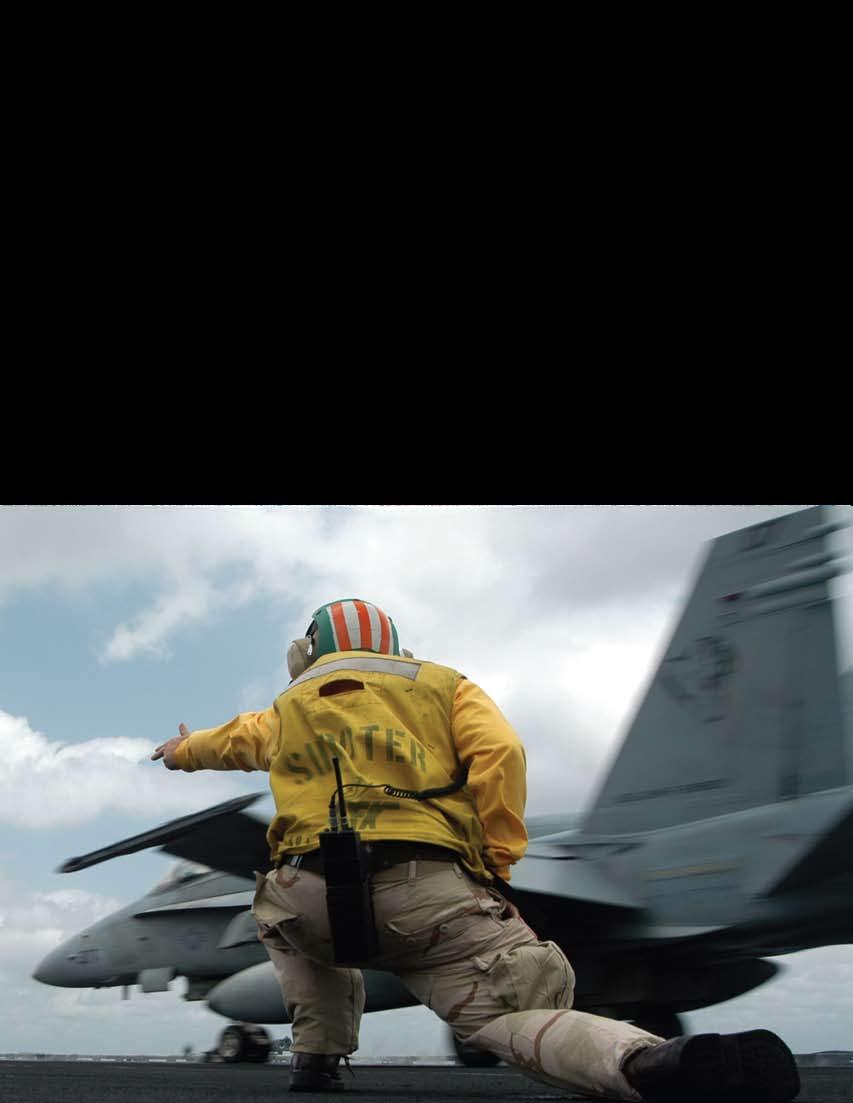
A “Shooter” launches an FA-18 Hornet assigned to the “Rampagers” of VFA-83 off the flight deck of USS John F. Kennedy (CV-67).
Navy photo by PH3 Joshua Karsten
and inspected after every 100 traps to verify their integrity. The preliminary investigation report pointed to a failure of the RRHB that caused it to only partly reset in the deck plate and therefore fail during my launch. Subsequent investigations by the air division showed that the ship had more RHHBs in the same unsatisfactory condition. Since the incident, all of the RHHBs have been inspected, and the failed ones have been replaced. As an additional measure, the “shooters” now incorporate a more stringent examination of the RHHB as part of their pre-launch checklist.
The above incident actually occurred on board CVN-67 in 2004. Working on catapults, arresting gear, and visual-landing aids on an aircraft-carrier flight deck is one of the most dangerous jobs in the world. The business of launching and arresting aircraft at sea requires very high system reliability: 99.9 percent. Over the years, airplanes have continued to increase in weight and speed, which increases the energy required to launch and recover airplanes. This also increases the stress, wear and tear on catapult and arresting-gear parts. These conditions have reduced the factors of safety for ALRE critical parts.
The ALRE community also faced issues that adversely affected how we bought parts. In fall 1999, defense-procurement agencies procured ALRE critical safety items improperly. Some of these parts did not meet engineering specification and had the potential to affect flight safety, including personnel safety. Parts delivered by these contracts had to be re-inspected by NAVAIR Lakehurst quality-assurance personnel. The resulting engineering investigations, which included sample inspections of each contract, revealed that components from 40 percent of the contracts did not conform to drawing specifications, and 20 percent were not approved for fleet use.
As a result, “ALRE Flight Safe,” now part of the Aircraft Launch and Recovery Equipment Maintenance Program (ALREMP 4790), was established to address these issues. NAVAIR Instruction 4200D, 20 June 2002, “Management of Critical Application Items including Critical Safety Items,” established policy, procedures, and assigned responsibility for the life-cycle management of replenishment items critical to naval-aviation safety. The ALRE flight-safe program is documented in NAVAIR Instruction 13800.18.
The three main elements of ALRE flight safe are: Special requirements for buying and inspecting critical safety parts, critical installation processes, and the design and development of new systems and service changes.
The first element pertains to the acquisition of ALRE safety critical parts or critical safety items (CSIs). CSIs are parts that can cause loss or serious damage to equipment, loss of aircraft, or serious injury or death to personnel when not properly manufactured. Of the 18,000 ALRE components, there are approximately 400 CSIs that have been identified and are part of the flightsafe program. The drawings used when buying all ALRE CSI parts have been revised to identify them as critical safety items, and more stringent quality-assurance requirements have been added to the inspection process. The CSI QA requirement includes a quality characteristics list (QCL) that is developed for each part. The QCL contains all of the major and critical dimensions and material properties for each part. CSI items are shipped to Lakehurst after procurement and before they are sent to the fleet for use. Lakehurst QA inspectors scrutinize each CSI item, and each part that meets the technical specifications is certified with a material identification code (MIC). The MIC is permanently marked on each inspected item or its packaging. This process ensures the delivery of quality parts to the fleet. The revised ALREMP OPNAVINST 4790.15D instruction has added a requirement for the shipboard Sailor to record the CSI MIC numbers in their maintenance-action forms. Each time a CSI component is used during maintenance of an ALRE system, the MIC marking now is recorded in block #35 of the MAF.
The second element of the program pertains to the control of critical installation processes. A critical ALRE installation process is any ALRE equipment installation process determined by NAVAIR Lakehurst engineering to be essential for safe ALRE system performance or operation. To date, eight critical catapult and arresting gear assemblies that can cause unsafe conditions have been identified.
The third element of ALRE flight safe deals with the design and development of new ALRE systems and service-change parts. Special design and test requirements and an extensive review process have been incorporated by Lakehurst senior engineers to make sure new ALRE systems and parts are designed with safety in mind. This process is invisible to the Sailor but is emphasized here to assure shipboard personnel that the engineers at Lakehurst have their safety in mind throughout the design and development process.
The NAVAIR ALRE flight-safe program has instituted processes and procedures to foster a safety focus on our equipment throughout its life cycle, from design to retirement from operation.
Ms. MacRae is the asst. program manager for training at NAVAIR Lakehurst, Code 6.7.5.1.
Send BZs to: SAFE-Mech@navy.

BZ Quarter of the
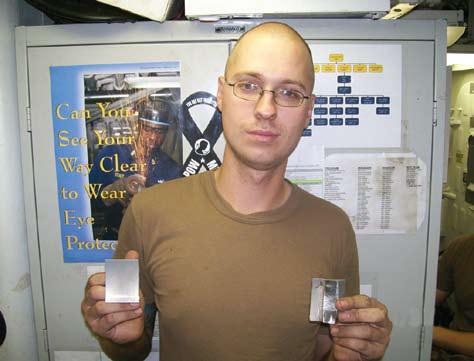
AM3 Timothy James HSL-42 Det. 5
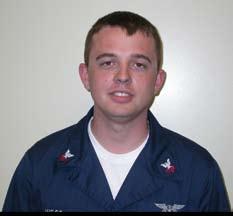
AD2 Eric Wood VPU-2
While inspecting a squadron aircraft for an E-handle vibration discrepancy, Petty Officer Wood noticed a crack on the firewall of engine No. 2. Further investigation revealed there were multiple cracks. He immediately notified Maintenance Control.
If the cracks had gone unnoticed, and if the aircraft landing gear had been raised, the potential would have existed for FOD and possible catastrophic damage to the landing gear. Petty Officer Wood’s alertness and safety attitude prevented possible aircraft damage or worse.
While doing a late night daily and turnaround inspection on Proud Warrior 437, Petty Officer James found a broken centering socket on the black rotor blade. This find was significant because the centering socket is not seen easily nor is it part of the checklist. He quickly notified his maintenance supervisor of the problem, and the aircraft was downed. The aircraft quickly was repaired and returned to meet operational commitments.
AO2(AW) Andy Boyd HSL-46
During a QA FOD check on Cutlass 472, Petty Officer Boyd found a screw lodged between the center stab and airframe fitting. The movement of this flight-control surface
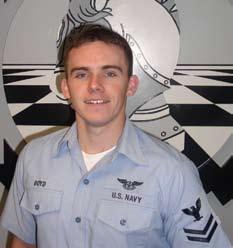
had caused the screw to damage both the center stab and the fitting. Maintenance Control was notified, and the aircraft was taken off the flight schedule.
Petty Officer Boyd’s meticulous inspection techniques allowed him to find a problem in an area that was very difficult to see. The piece of FOD in this critical flight-control surface could have caused control problems, possibly causing a mishap.
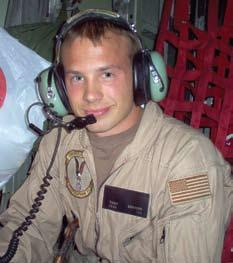
AT2 Brandon Potter VPU-2
Walking between his work center and Maintenance Control, Petty Officer Potter saw a civilian delivery truck trying to enter VPU-2’s hangar. While the spaces clearly were marked with “do not enter” and “open fuel cells” warning signs, the delivery truck continued its attempts.
Petty Officer Potter immediately stopped and rerouted the delivery truck. He was pivotal in preventing a fire and injury to personnel.

Displaying excellent CRM skills and situational awareness, he immediately and assertively told the aircraft commander, and the engine was shut down.
Inspection revealed the aft scavenge pump had failed and dumped excess oil into the exhaust flange. Continued operation of this engine likely would have led to an engine fire and possible injury or loss of life.
Petty Officer Bivona’s calibrated awareness of his environment and congruous reaction to the situation significantly reduced the possibility of a catastrophic mishap to a benign maintenance evolution.
AM2(AW/NAC) Timothy Lankford VR-53
As the aircrew of aircraft 164997 finished the before-start checklist, Petty Officer Lankford assumed his position in front of the aircraft for engine start. He was completing his final-visual inspection when he saw a substantial amount of fuel leaking from an area inboard of the No. 2 engine. He immediately informed the flight station of the problem and helped troubleshoot the leak. The leak was corrected, and in 30 minutes, the aircraft was ready to complete the remaining portion of the mission.
Petty Officer Lankford’s actions prevented a potential mishap, which could have resulted from a wing fire. His actions aided in assuring an on-time and completed NALO mission.
AT1(AW/NAC) Angelo Bivona VR-53
Aircraft 995 taxied for takeoff in Iwo Jima, Japan, when Petty Officer Bivona saw smoke billowing from the No. 1 engine exhaust.
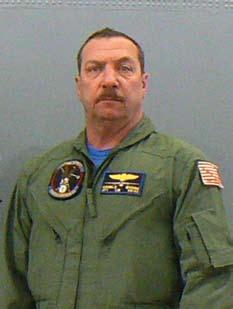
ABE2 Harry Webster
NAS Oceana Air Ops
During routine night operations at NAS Oceana, Petty Officer Webster reset an out-of-battery arresting gear several times. After resetting and inspecting the gear, he noticed
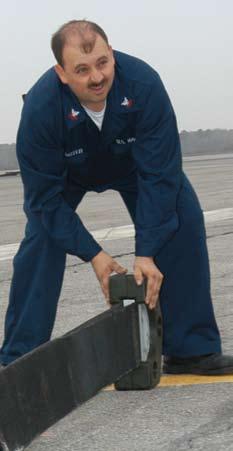
that an 8-by-10 foot section of the rubber-impact pad on the runway had separated completely from the attachment points. This left a large, shallow hole in the runway with exposed rebar bolts. Petty Officer Webster immediately notified the tower to wave off an FA-18 on short final. His actions prevented serious damage to the aircraft. Tower subsequently closed the runway.
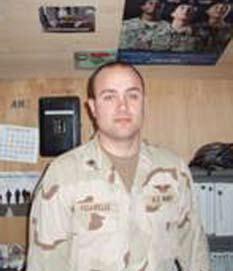
a sheared seal pressure and scavenge-tube assembly for the No. 1 engine. This gripe led to replacement of the engine. Were it not for Petty Officer Fejzo’s keen eye and attention to detail, the engine could have failed in flight.
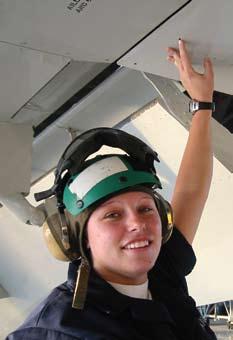
AM1 Joseph Figarelle VAQ-133
While inspecting the port wing of an EA-6B Prowler, Petty Officer Figarelle found that the outboard slat-torque tube had been ground down, almost to the point of breaking, by a screw that was too long. This screw could have caused a catastrophic flight-control failure and possibly injured or killed the aircrew.
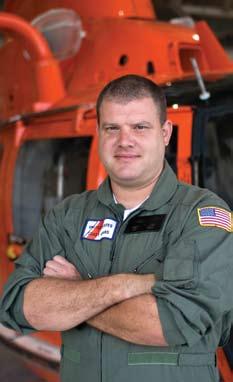
AWAN Erika Leffler VR-56
While doing a final walk-around with the aircrew on a C-9B, Airman Leffler found a screw sticking through a drain hole on the port aileron. Later investigation revealed this screw obstructed movement of the aileron and could have caused a flight-control failure.
On another pre-flight a week later, AWAN Leffler noticed that the service-door evacuation slide was installed incorrectly. Had an emergency evacuation occurred, the slide would not have deployed. In each of these cases, Airman Leffler’s attention to detail prevented a mishap.
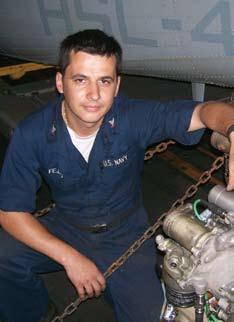
AM3 Eduard Fejzo HSL-44 Det. 10
During a 7-28-day special inspection on the detachment’s SH-60B, Petty Officer Fejzo found
AMT2 Jason Lee U.S. Coast Guard Air Station Miami
Petty Officer Lee deduced that a recently departed HH-65 was leaking oil. While co-workers questioned the possibility, he immediately made phone calls, and airtraffic control directed the helicopter to land.
On deck, the crew found the engine-oil reservoir below the sight gauge and oil leaking profusely from the engine. It was a great example of MRM, CRM, assertiveness, and just plain awareness. His actions directly prevented an in-flight emergency.










